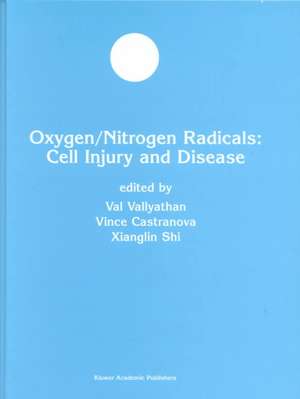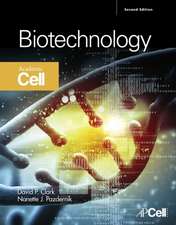Oxygen/Nitrogen Radicals: Cell Injury and Disease: Developments in Molecular and Cellular Biochemistry, cartea 37
Autor Val Vallyathan, Vince Castranova, Xianglin Shien Limba Engleză Hardback – 31 iul 2002
| Toate formatele și edițiile | Preț | Express |
|---|---|---|
| Paperback (1) | 962.66 lei 6-8 săpt. | |
| Springer Us – 31 oct 2012 | 962.66 lei 6-8 săpt. | |
| Hardback (1) | 839.38 lei 38-44 zile | |
| Springer Us – 31 iul 2002 | 839.38 lei 38-44 zile |
Din seria Developments in Molecular and Cellular Biochemistry
- 5%
 Preț: 389.20 lei
Preț: 389.20 lei - 24%
 Preț: 1056.97 lei
Preț: 1056.97 lei - 18%
 Preț: 1223.70 lei
Preț: 1223.70 lei - 24%
 Preț: 1060.04 lei
Preț: 1060.04 lei -
 Preț: 404.29 lei
Preț: 404.29 lei - 5%
 Preț: 371.30 lei
Preț: 371.30 lei - 18%
 Preț: 1555.51 lei
Preț: 1555.51 lei - 5%
 Preț: 734.57 lei
Preț: 734.57 lei - 24%
 Preț: 1568.12 lei
Preț: 1568.12 lei - 24%
 Preț: 1580.08 lei
Preț: 1580.08 lei - 24%
 Preț: 1584.02 lei
Preț: 1584.02 lei - 5%
 Preț: 365.61 lei
Preț: 365.61 lei - 24%
 Preț: 1564.06 lei
Preț: 1564.06 lei - 24%
 Preț: 1077.72 lei
Preț: 1077.72 lei - 15%
 Preț: 582.59 lei
Preț: 582.59 lei - 24%
 Preț: 1583.80 lei
Preț: 1583.80 lei - 5%
 Preț: 671.23 lei
Preț: 671.23 lei - 18%
 Preț: 1222.62 lei
Preț: 1222.62 lei - 24%
 Preț: 801.38 lei
Preț: 801.38 lei - 24%
 Preț: 1098.57 lei
Preț: 1098.57 lei - 18%
 Preț: 940.09 lei
Preț: 940.09 lei - 24%
 Preț: 1060.10 lei
Preț: 1060.10 lei - 5%
 Preț: 1003.85 lei
Preț: 1003.85 lei - 18%
 Preț: 935.67 lei
Preț: 935.67 lei - 5%
 Preț: 1418.48 lei
Preț: 1418.48 lei - 24%
 Preț: 795.19 lei
Preț: 795.19 lei - 18%
 Preț: 947.18 lei
Preț: 947.18 lei - 15%
 Preț: 643.00 lei
Preț: 643.00 lei - 24%
 Preț: 808.09 lei
Preț: 808.09 lei - 18%
 Preț: 951.29 lei
Preț: 951.29 lei
Preț: 839.38 lei
Preț vechi: 1104.44 lei
-24% Nou
Puncte Express: 1259
Preț estimativ în valută:
160.62€ • 168.04$ • 133.42£
160.62€ • 168.04$ • 133.42£
Carte tipărită la comandă
Livrare economică 29 martie-04 aprilie
Preluare comenzi: 021 569.72.76
Specificații
ISBN-13: 9781402070853
ISBN-10: 1402070853
Pagini: 420
Ilustrații: VIII, 406 p.
Dimensiuni: 210 x 279 x 31 mm
Ediția:2002
Editura: Springer Us
Colecția Springer
Seria Developments in Molecular and Cellular Biochemistry
Locul publicării:New York, NY, United States
ISBN-10: 1402070853
Pagini: 420
Ilustrații: VIII, 406 p.
Dimensiuni: 210 x 279 x 31 mm
Ediția:2002
Editura: Springer Us
Colecția Springer
Seria Developments in Molecular and Cellular Biochemistry
Locul publicării:New York, NY, United States
Public țintă
ResearchCuprins
Cyclic oxidation and reduction of protein methionine residues is an important antioxidant mechanism.- Signal transduction by nitric oxide in cellular stress responses.- Effects of antioxidants against atherosclerosis.- Molecular pathology of dityrosine cross-links in proteins: Structural and functional analysis of four proteins.- The role of nitric oxide in lung innate immunity: Modulation by surfactant protein-A.- Redox signaling.- Control of mitochondrial membrane potential and ROS formation by reversible phosphorylation of cytochrome c oxidase.- Molecular mechanisms of nitrogen dioxide induced epithelial injury in the lung.- Differential role of hydrogen peroxide in UV-induced signal transduction.- Upregulation of phosphoinositide 3-kinase and protein kinase B in alveolar macrophages following ozone inhalation. Role of NF-KB and STAT-1 in ozone-induced nitric oxide production and toxicity.- Phospholipase D/phosphatidic acid signal transduction: Role and physiological significance in lung.- Role of mitogen-activated protein kinases (MAPK) in cell injury and proliferation by environmental particulates.- Doxorubicin-induced apoptosis: Implications in cardiotoxicity.- Depletion of Bcl-2 by an antisense oligonucleotide induces apoptosis accompanied by oxidation and externalization of phosphatidylserine in NCI-H226 lung carcinoma cells.- Interactions of copper with glycated proteins: Possible involvement in the etiology of diabetic neuropathy.- Mechanisms of neutrophil-induced DNA damage in respiratory tract epithelial cells.- Asbestos-induced alveolar epithelial cell apoptosis: Role of mitochondrial dysfunction caused by iron-derived free radicals.- Involvement of hydrogen peroxide in asbestos-induced NFAT activation.- NF-KB, a pivotal transcription factor in silica-induced diseases.- Effect of inhaled crystalline silica in a rat model: Time course of pulmonary reactions.- The role of AP-1, NF-KB and ROS/NOS in skin carcinogenesis: The JB6 model is predictive.- Reactive oxygen species in choline deficiency induced carcinogenesis and nitrone inhibition.- Tumor necrosis factor-a gene promoter polymorphism in coal workers’ pneumoconiosis.- Nitric oxide decreases the sensitivity of pulmonary endothelial cells to LPS-induced apoptosis in a zinc-dependent fashion.- Cytokine polymorphisms in silicosis and other pneumoconioses.- Endogenous regulation of the acute inflammatory response.- Role of nitric oxide in liver ischemia and reperfusion injury.- Oxidative stress and TNF-a induce histone acetylation and NF-KB/AP-1 activation in alveolar epithelial cells: Potential mechanism in gene transcription in lung inflammation.- Heme oxygenase/carbon monoxide signaling pathways: Regulation and functional significance.- The role of oxidative stress in nickel and chromate genotoxicity.- Arsenic carcinogenicity: Relevance of c-Src activation.- Roles of ferritin and iron in ischemic preconditioning of the heart.- Molecular mechanisms of Cr(VI)-induced carcinogenesis.- Arsenic induces oxidative DNA damage in mammalian cells.- Generation of reactive oxygen species in the enzymatic reduction of PbCrO4 and related DNA damage.- Soluble metals as well as the insoluble particle fraction are involved in cellular DNA damage induced by particulate matter.- Nitroxides as antioxidants: Tempol protects against E09 cytotoxicity.- Reversal of fluoride induced cell injury through elimination of fluoride and consumption of diet rich in essential nutrients and antioxidants.- Measurements in vivo of parameters pertinent to ROS/RNS using EPR spectroscopy.- In vivo imagingof free radicals: Applications from mouse to man.- In vivo bioassays of acute asbestosis and its correlation with ESR spectroscopy and imaging in redox status.- On the application of 4-hydroxybenzoic acid as a trapping agent to study hydroxyl radical generation during cerebral ischemia and reperfusion.- In vivo detection of nitric oxide distribution in mice.- In vivo measurement of tumor redox environment using EPR spectroscopy.- Index to volume 234/235.- Instructions to Authors.











